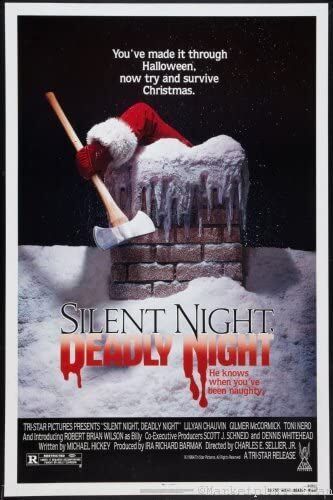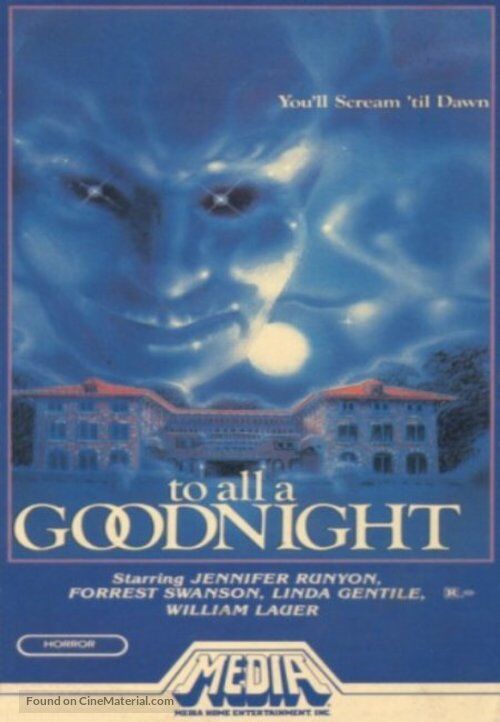By the time November rolls around some of us just plain aren’t ready to let the Halloween spirit die. Either that or we’re so obsessed with horror that it inevitably bleeds into every seasonal holiday we take part in. Either way, the best remedy is undoubtedly the abundance of killer Christmas horror movies available today; from the horrifyingly effective to the downright laughable, and sometimes both. Killer Santa Clauses have been stalking the silver screen since the late 70s, and filmmakers are coming up with fresh new ideas on seasonal scares to this day. With the holiday fast approaching, I have compiled a list of what I consider the most notable holly-jolly slashers, and while not all can be considered cinematic masterpieces, all can definitely be considered a bloody good time for gore-hounds wanting to celebrate the festive season with a splatter.
Silent Night, Deadly Night (1984)

This Charles E. Sellier directed slasher wasn’t the first time a maniacal killer donned a Santa suit, though it’s definitely one of the first that showed the true brutality the budding sub-genre had to offer. Silent Night, Deadly Night follows Billy, a troubled young man suffering from post-traumatic stress after being sole witness to the murder of his parents at the hands of a man dressed as Saint Nick himself. This, coupled with his subsequent abusive upbringing in a Catholic orphanage, picks away at his psyche until finally, in adulthood, he snaps and begins mirroring the man who brought about his parents demise. Billy dons a santa claus outfit and begins a spree of brutal murders in his hometown.
Silent Night, Deadly Night was met with its fair share of controversy over its depiction of a sadistic Saint Nick, being pulled from theatres a mere week after its release. Of course, as plenty of banned films do, it quickly achieved cult status and managed to spawn four sequels, with a reboot in the works for release this year.
Billy’s breakdown is, while dated in many regards, still a potent one. The eventual explosion of violence he undergoes is chock full of the mean-spirited dispatching of innocents that we have come to expect from slashers. Although, the personal dramas Billy deals with throughout the films runtime are just as endearing, and we are met with just as much human tragedy as we are mindless violence in this rough-but-ready Christmas horror movie relic.
To All A Goodnight (1980)

Interestingly enough, this slice of festive nastiness was directed by none other than actor David A. Hess, known for his own roles depicting gruff and often murderous villains. Some would argue that David may have been better in front of the camera for this low-budget slasher, and it’s easy to see why. To All a Goodnight flew under just about everyone’s radar at the time, despite coming out before the likes of Silent Night, Deadly Night and around the same time as the likes of “You Better Watch Out”. Even so, this is a particularly vicious and atmospheric Christmas horror slasher that should be on every genre fan’s watchlist at least once.
Like many slashers of its era, This one opens with a flashback to a prank going terribly wrong before moving to the present, where a group of wealthy students of a Finishing School for Girls plan to sneak their boyfriends in for a late night party. Their plans are ruined, however, when someone dressed in a Santa costume begins stalking the halls, dispatching them one-by-one.
There are some interesting kills on show here, and a suitably rough and unhinged electronic score permeating the festive filleting of surprisingly halfway decent actors. Each character manages to bring something distinct to the table, making this an under appreciated and worthy Santa slasher.
Sint (2010)

Sint, also known as Saint in Europe and Saint Nick in the US, is a Dutch black-comedy about the legend of Sinterklaas, the character upon which our lovable modern Santa Claus is based. Sint distorts myth and reality, portraying Sinterklaas as a homicidal ghost who murders huge amounts of people when Christmas coincides with a full moon. The film was directed by Dick Maas, who gained critical acclaim with such horrors as De Lift (1983) and Amsterdamned (1988), and is seen widely as a return to form after a long absence.
Sint is a surreal and polarizing affair on the whole, some feeling the potential its concept set wean’t fully realized. That being said, the bizarre and action-packed spectacle we are left with is, while tamer than most yuletide horrors, more than entertaining and darkly funny enough to satiate the Christmas horror movie genre fans years down the line.
Rare Exports (2010)

For our next look into crimbo carnage we head to Finland for the modern fantasy/action horror Rare Exports, directed by Jalmari Helander. The story centres around Pietari, a young boy living in the mountains of Northern Finland. He and his friend Juuso uncover plans of a secret mountain drilling project that they believe has uncovered a tomb. The tomb of Santa Claus himself. Of course this is a Christmas horror movie, so the Saint Nick that is uncovered and expectedly rises from his grave is not as jolly as one might hope. All hope may rest in an old wildman who becomes ensnared in one of Pietari’s father’s wolf traps, who may know more than he is letting on about the recent children’s disappearances and reindeer’s slaughter.
The story begins slowly, ramping up the suspense before the deliciously savage killing begins. Each character is given room to breathe and establish themselves, adding real weight to the carnage that follows. The end result is something beyond a simple b-movie slasher; a unique, unsettling and often hilarious Santa Claus origin story that reminds us that all fairy tales are truly dark if you dig deep enough.
Christmas Evil (1980)

Christmas Evil is a bit of a wildcard. This mean-spirited proto-slasher being more an exploitation film than anything would usually mean buckets of blood and some risque content that wider audiences would have difficulty with. This is by all means a nasty and uncompromising film, though it seems more concerned with mood and atmosphere than with shocking its audiences with gore and nudity.
Brandon Maggart plays a toymaker who has loves Christmas since he was a young boy. He is scarred when he realises Santa isn’t real and vows then to keep the Christmas spirit a reality, becoming obsessed with children’s behaviour and the quality of his own creations. He eventually snaps when people meet his efforts with a cold cynicism, causing him to begin a killing spree dressed as his lifelong hero, jolly Saint Nick.
Maggart plays Harry with an intensity that brings to mind broken characters such as Travis Bickle and even Michael Rooker’s ‘Henry’. This coupled with Christmas Evil being the first film to feature Santa as a killer elevated it above plenty of the Christmas horror movies of its era.
Tales From The Crypt (1972)

When a group of tourists become lost in a labyrinth of ancient catacombs, they come across the Crypt Keeper (played by Ralph Richardson) who tells each of them their fate in the form of five short films. Not only does Tales From The Crypt feature one of the scariest killer Santas in cinema history, but it manages to be a cut above other anthology horror films by a wide margin in terms of quality and overall scares. The tales include a murderous spouse, a man who becomes the target of nosy and suspicious neighbors, and an adulterer who may meet a fitting end if the keeper’s predictions are accurate.
This was arguably the first film to feature a homicidal Santa Claus, though not as its main crux.
A Christmas Horror Story (2015)

The idea of a killer Santa is turned gleefully on its head in this fun action/horror from directors Grant Harvey, Steven Hoban and Brett Sullivan. The small Town of Bailey Downs is suddenly set upon by a maelstrom of Christmas chaos, including insidious spirits, zombified elves and none other than the anti-Santa himself, Krampus.
A Christmas Horror Story has something for everyone; the uninitiated will enjoy the simplicity and accessibility of the story while more hardcore fans will recognise references such as Bailey Downs from the film’s opening.
All in all this manages to be one of the stronger horror anthologies out there, especially since it is dedicated fully to modernising an old tale with a brutal new twist. Don’t miss it.
Black Christmas (1974)

And finally we come to one of the most influential and to-this-day unsettling of all the Christmas horror movies. Black Christmas set the stage for slashers in the late 70s and early 80s, creating many of the conventions we know and love them for today.
As winter settles in, a shout of sorority sisters begin receiving aggressive and sexual phone calls from an anonymous psycho. One thing we can tell from the squealing voice is that its owner is very disturbed and very dangerous. Margot Kidder does a great job as the unhinged and inebriated ‘Barb’, who gleefully eggs on the caller until he becomes threatening. When the girls hear of a local girls murder, and one of their own goes missing too, they begin to suspect the calls may have been more threatening than they appeared, and none of them have any idea just how close the danger is.
And as an audience we feel every bit of that danger. Because Black Christmas is from a time before established slasher tropes, there are no fixed rules for who will live and who will die. Not even a ‘final girl’ is guaranteed amongst the colourful group, making this nasty yuletide spree a worthy entry in any horror fan’s rotation. There’s a reason so many tried to emulate what Black Christmas did, and the templates it set in stone are still revered to this day.
Joe first knew he wanted to write in year six after plaguing his teacher’s dreams with a harrowing story of World War prisoners and an insidious ‘book of the dead’. Clearly infatuated with horror, and wearing his influences on his sleeve, he dabbled in some smaller pieces before starting work on his condensed sci-fi epic, System Reset in 2013.Once this was published he began work on many smaller horror stories and poems in bid to harness and connect with his own fears and passions and build on his craft.
Joe is obsessed with atmosphere and aesthetic, big concepts and even bigger senses of scale, feeding on cosmic horror of the deep sea and vastness of space and the emotions these can invoke. His main fixes within the dark arts include horror films, extreme metal music and the bleakest of poetry and science fiction literature.
He holds a deep respect for plot, creative flow and the context of art, and hopes to forge deeper connections between them around filmmakers dabbling in the dark and macabre.
